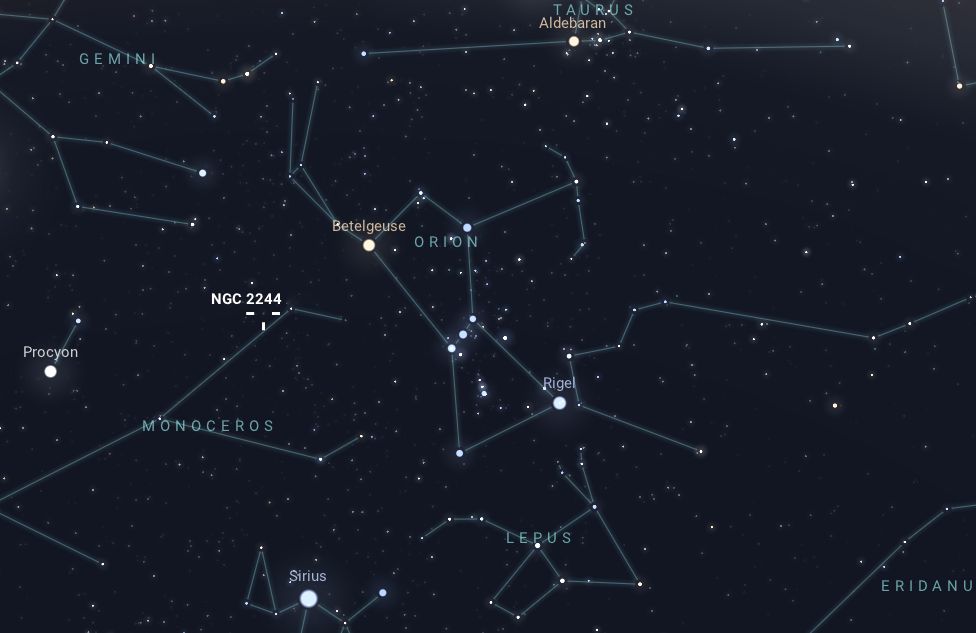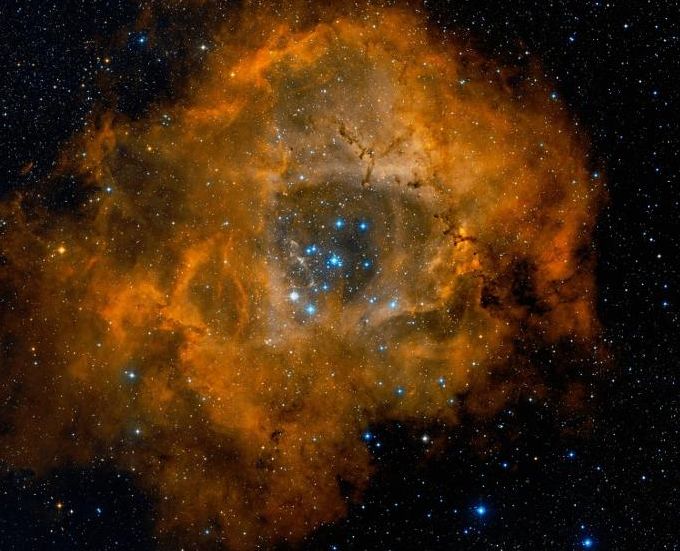NGC 2244, also known as Caldwell 50 or the Satellite Cluster, is a young open star cluster within the Rosette Nebula, located in the equatorial constellation of Monoceros. Approximately 5,000 light-years away, it lies within one of the spiral arms of the Milky Way galaxy.
The cluster was first discovered by British astronomer John Flamsteed in the late 17th century and later catalogued independently by French astronomer Charles Messier in 1769 as part of his Messier Catalogue.
Physical Characteristics
NGC 2244 contains hundreds of young, hot, blue stars that formed directly from the Rosette Nebula—a vast cloud of gas and dust rich in star-forming materials. Over time, regions of this molecular cloud collapsed under gravity, creating dense, hot pockets where new stars ignited. Estimated to be around 4 million years old, NGC 2244 is relatively young, with all its stars originating from this same molecular cloud in which it is embedded.
Ultraviolet radiation from these young stars ionizes the surrounding gas, causing the nebula to glow and framing the cluster in a radiant halo of gas and dust. The stars in NGC 2244 form a compact, dense arrangement, highlighted by the nebula’s intricate structure, making it a visually captivating and dynamic example of star formation.
Observation
With an apparent magnitude of about 4.8, NGC 2244 is visible to the naked eye under dark skies but can be seen more clearly with binoculars or a small telescope. In binoculars, it appears as a faint but distinct cluster of stars set against the dimly lit background of the Rosette Nebula. While the nebula’s glowing gas and dust are usually too faint to be visible in standard binoculars, the cluster’s stars stand out, forming a loose, somewhat circular grouping. Under dark skies, binoculars may reveal a subtle glow around the stars, hinting at the nebula’s presence.
Through a small telescope, NGC 2244 takes on more detail. The cluster’s bright, young stars become more distinct, and at higher magnifications, individual stars and the compact arrangement of the cluster are easily resolved. The Rosette Nebula’s faint glow and structure start to emerge in telescopes with a wider aperture (8 inches or more), where hints of swirling gas and dark lanes surrounding the cluster may be visible under optimal viewing conditions.

Situated in the equatorial constellation of Monoceros, the cluster is observable from both hemispheres. In the northern hemisphere it is best viewed during winter, from December to February, when Monoceros is prominent in the evening sky. From the Southern Hemisphere, it is visible from December to April (summer to autumn), though it appears lower on the horizon.
Overall, NGC 2244, with its distinctive star formation within the Rosette Nebula, is a striking cluster that provides a captivating subject of study for astronomers.



